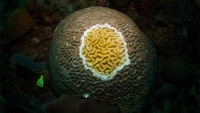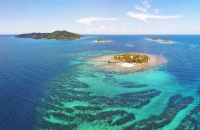What species of groupers can you see in Roatán and the Bay Islands?
There are approximately 150 different kinds of groupers in the world. Thirty-seven species are known to spawn in the Caribbean including the waters throughout the Bay Islands.
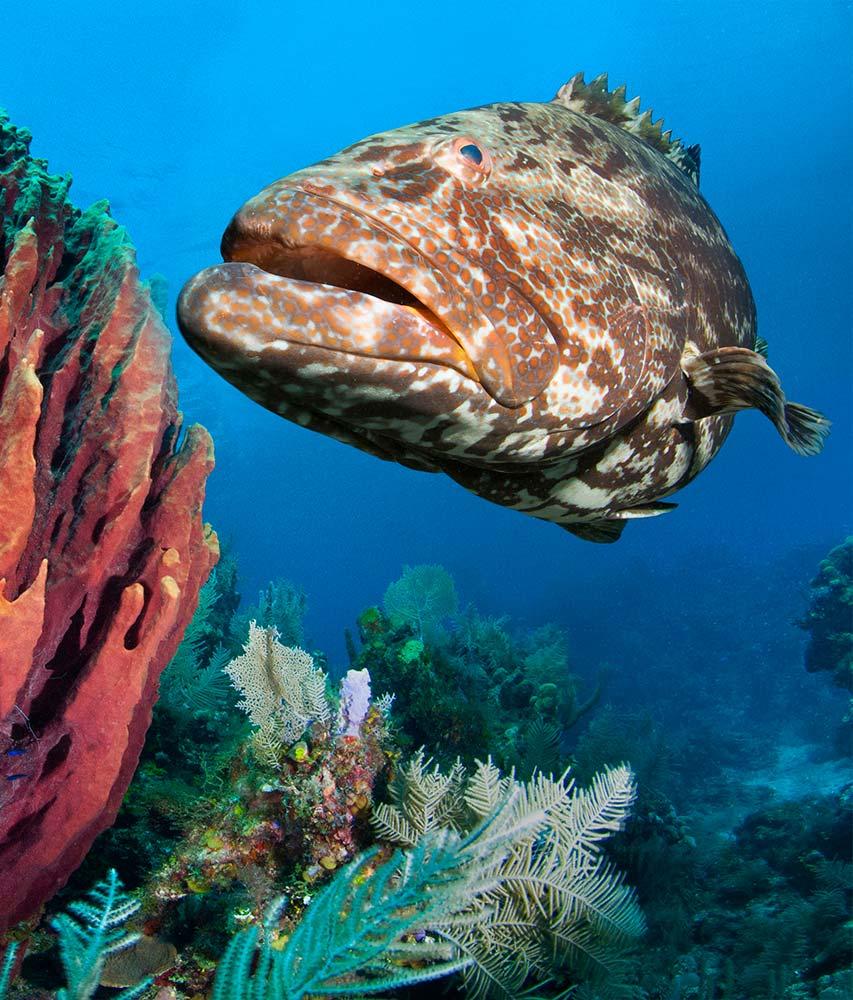
GROUPER
• Class: Actinopterygii
• Order: Perciformes
• Family: Serranidae
• Subfamily: Epinephelinae
Here is a list of the most common groupers that can been seen diving in the Bay Islands: BLACK GROUPER - NASSAU GROUPER - RED HIND, ROCK HIND - TIGER GROUPER - GRAYSBY - YELLOWFIN GROUPER - YELLOWMOUTH GROUPER - CONY - GOLIATH GROUPER.
Most grouper species are coastal demersal fish, which means they usually live and eat near the sea floor. They are not designed for long and fast swimming. Some groupers can be quite large, and measure over a meter. The huge Goliath grouper can grow up to 8.2 feet (2.5 m). Others, like the Graysby, can be as small as 7 in (17 cm).
All varietals of groupers are opportunistic predators, they eat a wide variety of foods. While they prefer to eat fish, they often eat crustaceans and invertebrates like octopus and squid. Since they don’t have many teeth, they swallow prey rather than biting them. They use their big wide mouths and powerful gill muscles to create a strong suction that can suck the designed victim even from a distance. Some species prefer to ambush their prey, while other species are active predators.
Groupers are mostly monandric protogynous hermaphrodites. They are born and mature as females but they have the ability to change their sex for reproduction purposes. Black groupers are very easy to spot while others, like the Goliath grouper are more difficult to find.
Groupers can live quite long. Scientists estimate they can live up to 50 years, sometimes even longer.
What species of groupers can you see in Roatán and the Bay Islands?
There are approximately 150 different kinds of groupers in the world. Thirty-seven species are known to spawn in the Caribbean including the waters throughout the Bay Islands. Here is a list of the most common groupers that can been seen diving in the Bay Islands: BLACK GROUPER - NASSAU GROUPER - RED HIND, ROCK HIND - TIGER GROUPER - GRAYSBY - YELLOWFIN GROUPER - YELLOWMOUTH GROUPER - CONY - GOLIATH GROUPER.
Most grouper species are coastal demersal fish, which means they usually live and eat near the sea floor. They are not designed for long and fast swimming. Some groupers can be quite large, and measure over a meter. The huge Goliath grouper can grow up to 8.2 feet (2.5 m). Others, like the Graysby, can be as small as 7 in (17 cm).
All varietals of groupers are opportunistic predators, they eat a wide variety of foods. While they prefer to eat fish, they often eat crustaceans and invertebrates like octopus and squid. Since they don’t have many teeth, they swallow prey rather than biting them. They use their big wide mouths and powerful gill muscles to create a strong suction that can suck the designed victim even from a distance. Some species prefer to ambush their prey, while other species are active predators.
Groupers are mostly monandric protogynous hermaphrodites. They are born and mature as females but they have the ability to change their sex for reproduction purposes. Black groupers are very easy to spot while others, like the Goliath grouper are more difficult to find.
Groupers can live quite long.
Scientists estimate they can live up to 50 years, sometimes even longer.

GROUPER
• Class: Actinopterygii
• Order: Perciformes
• Family: Serranidae
• Subfamily: Epinephelinae
NASSAU GROUPER (Epinephelus striatus)

Nassau is probably the most well know grouper, thanks to its unique pattern and body color. It is known to change from tawny, for the ones living in shallow water, to pinkish, red, or sometimes orange-red for specimens living in deeper waters. Nassau grouper has been overfished for years and is listed as threatened under the Endangered Species Act.
Nassau Groupers can live up to 29 years. They can be found offshore on rocky reefs and drop offs. Juveniles can most commonly be seen in shallow water on the nearshore reefs.
• MAX SIZE: 3,5 ft (100 cm)
• MAX WEIGH: 55 lbs (25 kg)
• DEPTH RANGE: 20 - 426 ft (6 - 130mt)
NASSAU GROUPER (Epinephelus striatus)
Nassau is probably the most well know grouper, thanks to its unique pattern and body color. It is known to change from tawny, for the ones living in shallow water, to pinkish, red, or sometimes orange-red for specimens living in deeper waters. Nassau grouper has been overfished for years and is listed as threatened under the Endangered Species Act.
Nassau Groupers can live up to 29 years. They can be found offshore on rocky reefs and drop offs. Juveniles can most commonly be seen in shallow water on the nearshore reefs.
• MAX SIZE: 3,5 ft (100 cm)
• MAX WEIGH: 55 lbs (25 kg)
• DEPTH RANGE: 20 - 426 ft (6 - 130mt)

TIGER GROUPER (Mycteroperca tigris)
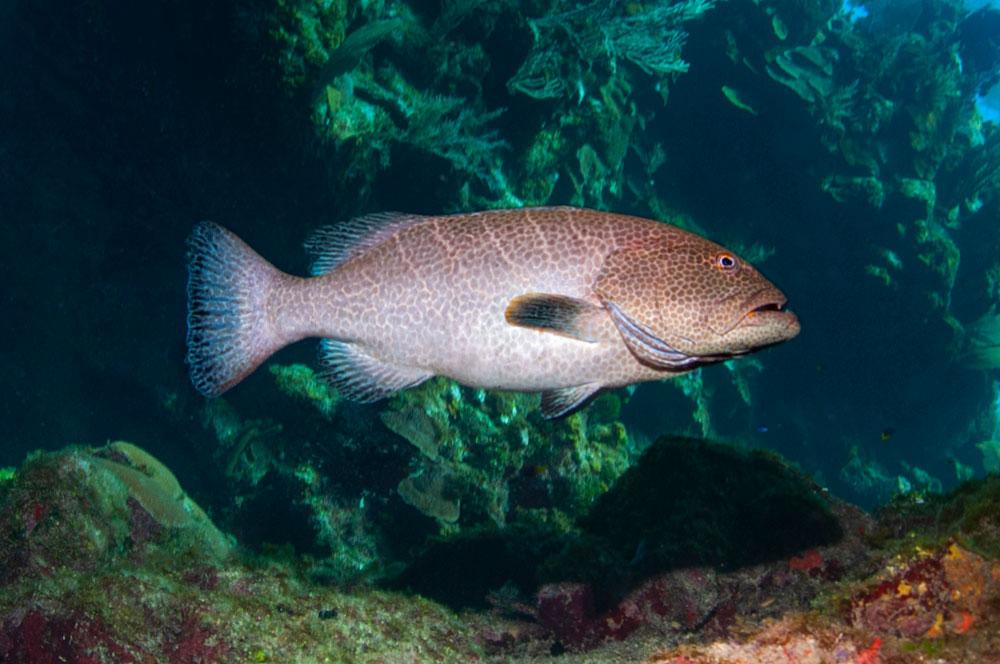
This grouper has a strong stretched body, usually reddish with many vertical stripes and sometimes darker lines on the sides. Young individuals have a yellow colour. Tiger grouper is a solitary hunter. It is considered an ambush predator that hides amongst the coral and sponges and feeds mainly on fish.
Tiger grouper can live up to 30 years and can easily be found in coral reefs and rocky areas. They can dramatically change color from pale to dark and bright red, especially when visiting cleaning stations.
• MAX SIZE: 3,5 ft (100 cm)
• MAX WEIGH: 57 lbs (26 kg)
• DEPTH RANGE: 3 - 200 ft (1 - 60mt)
TIGER GROUPER (Mycteroperca tigris)
This grouper has a strong stretched body, usually reddish with many vertical stripes and sometimes darker lines on the sides. Young individuals have a yellow colour. Tiger grouper is a solitary hunter. It is considered an ambush predator that hides amongst the coral and sponges and feeds mainly on fish.
Tiger grouper can live up to 30 years and can easily be found in coral reefs and rocky areas. They can dramatically change color from pale to dark and bright red, especially when visiting cleaning stations.
• MAX SIZE: 3,5 ft (100 cm)
• MAX WEIGH: 57 lbs (26 kg)
• DEPTH RANGE: 3 - 200 ft (1 - 60mt)

BLACK GROUPER (Mycteroperca bonaci)

Black Grouper is one of the most common type of groupers found in the Caribbean. Their bodies are olive, grey or brown and covered by irregular rectangle black blotches and spots. It's a solitary fish and it spawns between May and August with a lifespan of 40 years. Adults feed mainly on other fish and squid, while juveniles primarily feed on crustaceans.
Black Grouper are normally found offshore in deep water with rocky bottoms, reef, and drop off walls. Adult groupers also like living near wrecks, while juveniles can be found in shallow water inshore.
• MAX SIZE: 5 ft (150 cm)
• MAX WEIGH: 220 lbs (100 kg)
• DEPTH RANGE: 20 - 110 ft (6 - 33mt)
BLACK GROUPER (Mycteroperca bonaci)
Black Grouper is one of the most common type of groupers found in the Caribbean. Their bodies are olive, grey or brown and covered by irregular rectangle black blotches and spots. It's a solitary fish and it spawns between May and August with a lifespan of 40 years. Adults feed mainly on other fish and squid, while juveniles primarily feed on crustaceans.
Black Grouper are normally found offshore in deep water with rocky bottoms, reef, and drop off walls. Adult groupers also like living near wrecks, while juveniles can be found in shallow water inshore.
• MAX SIZE: 5 ft (150 cm)
• MAX WEIGH: 220 lbs (100 kg)
• DEPTH RANGE: 20 - 110 ft (6 - 33mt)

RED HIND (Epinephelus guttatus)

Red Hind also known as Speckled Hind has a strong, sometimes almost white body covered by reddish spots. The tail edge is black with a thin white edge. Unlike the Rock Hind, they don't have any spot on their tails or dorsal fin. Unfortunately, like the Nassau grouper, they are known as very tasty and have been overfished in many places.
The life expectancy of Red Hind is around 17 years. They can be found in shallow reefs and rocky bottoms. They are usually solitary fish and very territorial.
• MAX SIZE: 30 in (76 cm)
• MAX WEIGH: 49 lbs (22 kg)
• DEPTH RANGE: 10 - 160 ft (3 - 50mt)
RED HIND (Epinephelus guttatus)
Red Hind also known as Speckled Hind has a strong, sometimes almost white body covered by reddish spots. The tail edge is black with a thin white edge. Unlike the Rock Hind, they don't have any spot on their tails or dorsal fin. Unfortunately, like the Nassau grouper, they are known as very tasty and have been overfished in many places.
The life expectancy of Red Hind is around 17 years. They can be found in shallow reefs and rocky bottoms. They are usually solitary fish and very territorial.
• MAX SIZE: 30 in (76 cm)
• MAX WEIGH: 49 lbs (22 kg)
• DEPTH RANGE: 10 - 160 ft (3 - 50mt)

ROCK HIND (Epinephelus adscensionis)

Very similar to the above Red Hind but with few differences.The Rock Hind robust compressed strong body does not have a black tail edge and it is smaller in size. The color of the body is tan and the reddish spots also cover the tail and the dorsal fin while they are absent in the Red Hind. They are both able to twist and turn their eyes in their sockets.
Much less elusive than the Red hind, Rock hind groupers can easily be approached. This grouper inhabits rocky reefs, and it is usually solitary. It feeds mainly on crabs and fish and can live up to 30 years old.
• MAX SIZE: 2 ft (65 cm)
• MAX WEIGH: 19 lbs (9 kg)
• DEPTH RANGE: 3 - 400 ft (1 - 120mt)
ROCK HIND (Epinephelus adscensionis)
Very similar to the above Red Hind but with few differences.The Rock Hind robust compressed strong body does not have a black tail edge and it is smaller in size. The color of the body is tan and the reddish spots also cover the tail and the dorsal fin while they are absent in the Red Hind. They are both able to twist and turn their eyes in their sockets.
Much less elusive than the Red hind, Rock hind groupers can easily be approached. This grouper inhabits rocky reefs, and it is usually solitary. It feeds mainly on crabs and fish and can live up to 30 years old.
• MAX SIZE: 2 ft (65 cm)
• MAX WEIGH: 19 lbs (9 kg)
• DEPTH RANGE: 3 - 400 ft (1 - 120mt)

GRAYSBY (Epinephelus cruentata)

Graysby is the smallest grouper that inhabits the Bay Islands waters. Its body is small but strong; light reddish sometimes brown to gray, with darker orangish spots. Its distinctive sign is three to five very dark spots along the base of the dorsal fin. Graysby is a nocturnal predator. The adults eat mainly small fish while juveniles prefer shrimps.
Graysby is a solitary and very secretive grouper, usually likes to stay in seagrass beds or swim on coral reefs, close to hiding places during the day. Its lifespan is about 13 years.
• MAX SIZE: 15 in (40 cm)
• MAX WEIGH: 2,2 lbs (1 kg)
• DEPTH RANGE: 10 - 89 ft (3 - 27mt)
GRAYSBY (Epinephelus cruentata)
Graysby is the smallest grouper that inhabits the Bay Islands waters. Its body is small but strong; light reddish sometimes brown to gray, with darker orangish spots. Its distinctive sign is three to five very dark spots along the base of the dorsal fin. Graysby is a nocturnal predator. The adults eat mainly small fish while juveniles prefer shrimps.
Graysby is a solitary and very secretive grouper, usually likes to stay in seagrass beds or swim on coral reefs, close to hiding places during the day. Its lifespan is about 13 years.
• MAX SIZE: 15 in (40 cm)
• MAX WEIGH: 2,2 lbs (1 kg)
• DEPTH RANGE: 10 - 89 ft (3 - 27mt)

YELLOWFIN GROUPER (Mycteroperca venenosa)
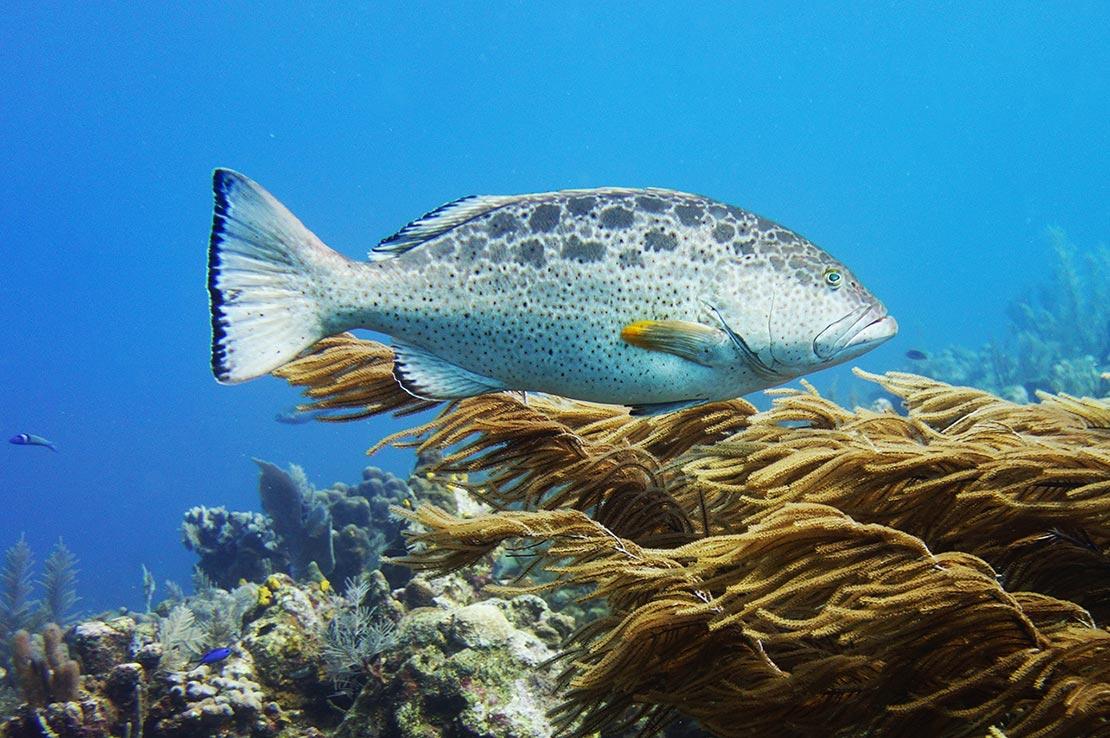
Yellowfin grouper has a compact body with two color morphs: greenish gray for the specimens that live in shallow water and bright red for the ones that live in deeper water. In both cases the entire body is covered by oval groups of dark spots. This grouper takes its name from its bright yellow pectoral fins, which are also its distinctive sign.
Yellow grouper feeds mainly on coral reef fishes and squids and is found on rocky and coral reefs. The juveniles like to stay in shallow turtle grass beds. They can live up to 37 years old.
• MAX SIZE: 3 ft (100 cm)
• MAX WEIGH: 39 lbs (18 kg)
• DEPTH RANGE: 10 - 120 ft (3 - 37mt)
YELLOWFIN GROUPER (Mycteroperca venenosa)
Yellowfin grouper has a compact body with two color morphs: greenish gray for the specimens that live in shallow water and bright red for the ones that live in deeper water. In both cases the entire body is covered by oval groups of dark spots. This grouper takes its name from its bright yellow pectoral fins, which are also its distinctive sign.
Yellow grouper feeds mainly on coral reef fishes and squids and is found on rocky and coral reefs. The juveniles like to stay in shallow turtle grass beds. They can live up to 37 years old.
• MAX SIZE: 3 ft (100 cm)
• MAX WEIGH: 39 lbs (18 kg)
• DEPTH RANGE: 10 - 120 ft (3 - 37mt)

YELLOWMOUTH GROUPER (Mycteroperca interstitialis)
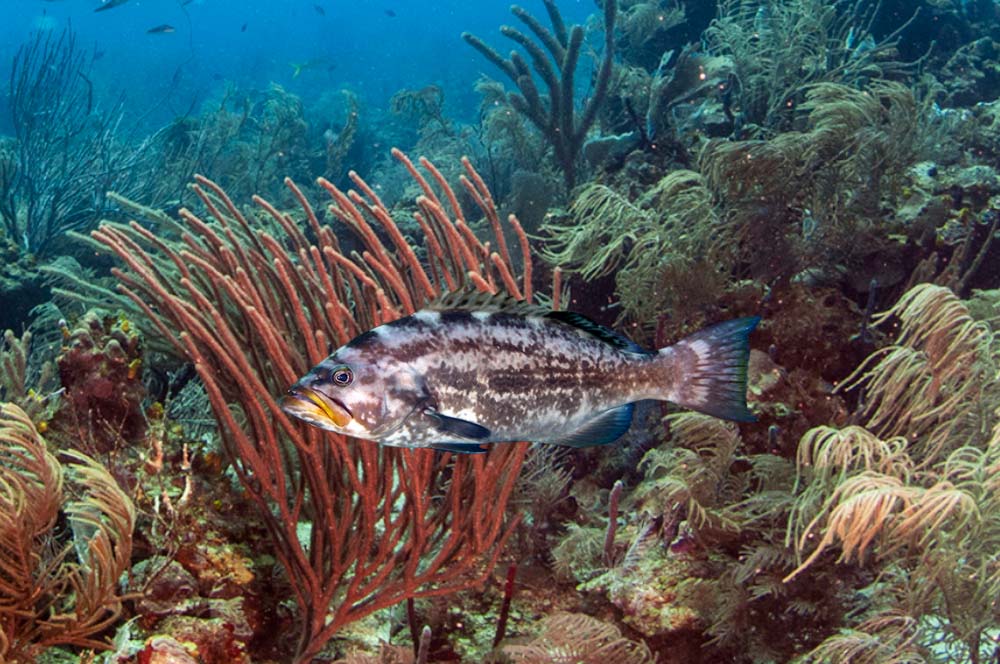
The Yellowmouth grouper, also known with several other names like: Crossband rockfish, Grey mannock, Hamlet, Salmon grouper and more, is a fairly large and robust grouper which gets its name from the yellow around its mouth. Its body has rusty brown stripes on the sides with some yellow marks and a white underbelly.
They can live up to 45 years and even if they can occasionally be seen in shallower waters, they are normally found on rocky bottoms and coral beds around 80 feet.
• MAX SIZE: 30 in (70 cm)
• MAX WEIGH: 22 lbs (10 kg)
• DEPTH RANGE: 10 - 80 ft (3 - 25mt)
YELLOWMOUTH GROUPER (Mycteroperca interstitialis)
The Yellowmouth grouper, also known with several other names like: Crossband rockfish, Grey mannock, Hamlet, Salmon grouper and more, is a fairly large and robust grouper which gets its name from the yellow around its mouth. Its body has rusty brown stripes on the sides with some yellow marks and a white underbelly.
They can live up to 45 years and even if they can occasionally be seen in shallower waters, they are normally found on rocky bottoms and coral beds around 80 feet.
• MAX SIZE: 30 in (70 cm)
• MAX WEIGH: 22 lbs (10 kg)
• DEPTH RANGE: 10 - 80 ft (3 - 25mt)

CONEY (Epinephelus fulvus)
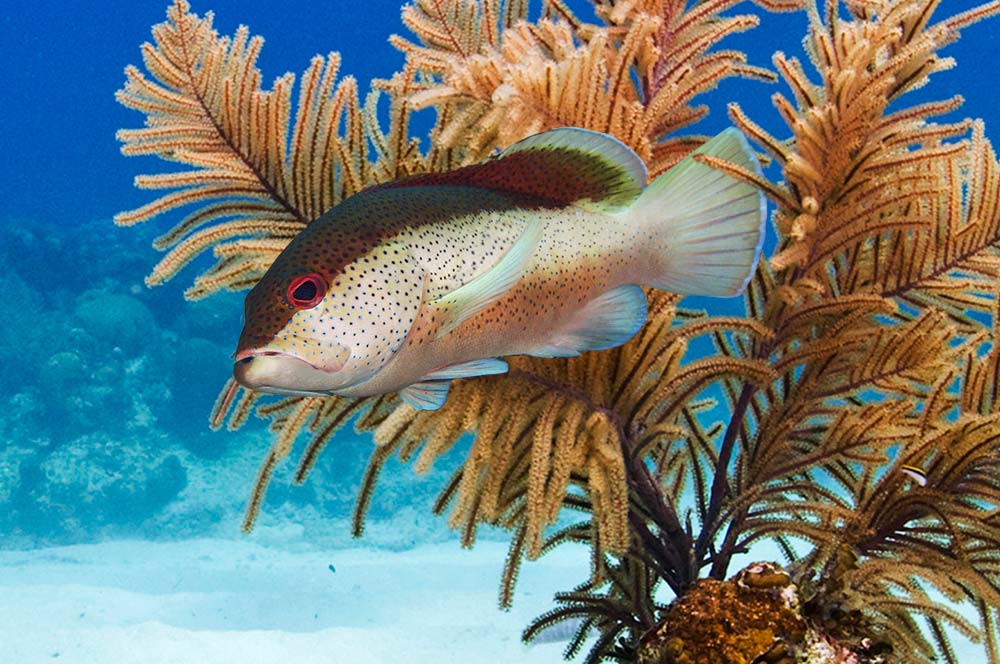
Coney has three different color varieties: The reddish brown one found in deep water, the bicolored orange and light brown one found in shallow water and the yellow one which can be found from shallow to deep water. The reddish brown is most common for Coney grouper. Two notable dark spots and a pair of black blotches on the tip of the lower jaw are present in all three varieties.
Coney prefers coral reefs and clear water. Males are territorial and feed mainly on small fish and crustaceans. They can live up to 25 years.
• MAX SIZE: 17 in (44 cm)
• MAX WEIGH: 4 lbs (1,8 kg)
• DEPTH RANGE: 3 - 230 ft (1 - 70mt)
CONEY (Epinephelus fulvus)
Coney has three different color varieties: The reddish brown one found in deep water, the bicolored orange and light brown one found in shallow water and the yellow one which can be found from shallow to deep water. The reddish brown is most common for Coney grouper. Two notable dark spots and a pair of black blotches on the tip of the lower jaw are present in all three varieties.
Coney prefers coral reefs and clear water. Males are territorial and feed mainly on small fish and crustaceans. They can live up to 25 years.
• MAX SIZE: 17 in (44 cm)
• MAX WEIGH: 4 lbs (1,8 kg)
• DEPTH RANGE: 3 - 230 ft (1 - 70mt)

GOLIATH GROUPER (Epinephelus itajara)
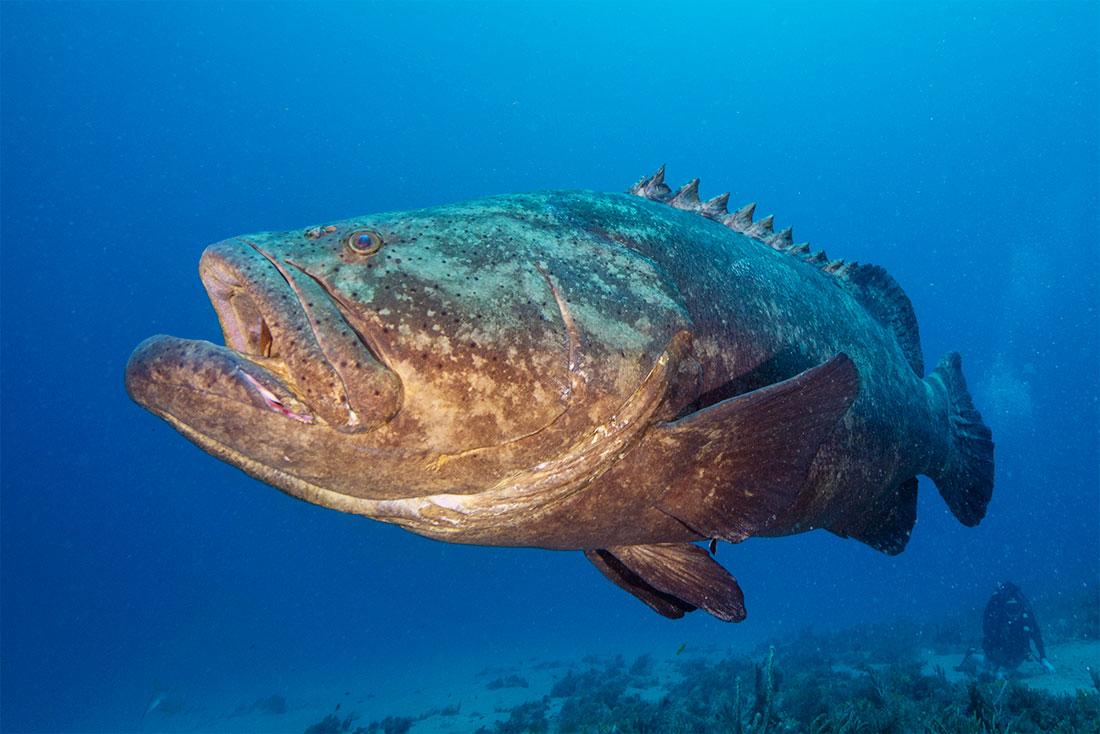
Goliath grouper is the largest member of the grouper family. Its big and strong body is usually mottled yellow-brown to grey with darker stripes and spots. It is a solitary fish and very territorial. When threatened it shows aggressive body language and a rumbling sound produced from its swim bladder.
Rare to be seen, they live around rocky coral and muddy inshore habitats. They eat everything in sight; crustaceans, fish, stingray, young sea turtles and even small sharks. They can live up to 50 years.
• MAX SIZE: 8,2 ft (2,5 mt)
• MAX WEIGH: 800 lbs (363 kg)
• DEPTH RANGE: 16 - 500 ft (5 - 150mt)
GOLIATH GROUPER (Epinephelus itajara)
Goliath grouper is the largest member of the grouper family. Its big and strong body is usually mottled yellow-brown to grey with darker stripes and spots. It is a solitary fish and very territorial. When threatened it shows aggressive body language and a rumbling sound produced from its swim bladder.
Rare to be seen, they live around rocky coral and muddy inshore habitats. They eat everything in sight; crustaceans, fish, stingray, young sea turtles and even small sharks. They can live up to 50 years.
• MAX SIZE: 8,2 ft (2,5 mt)
• MAX WEIGH: 800 lbs (363 kg)
• DEPTH RANGE: 16 - 500 ft (5 - 150mt)



